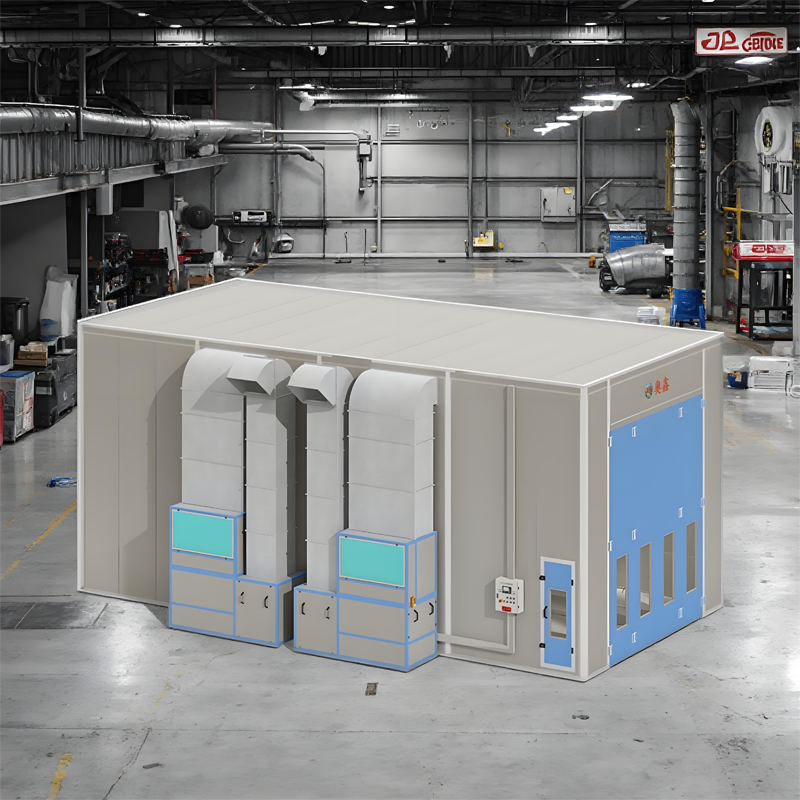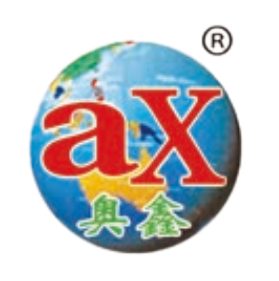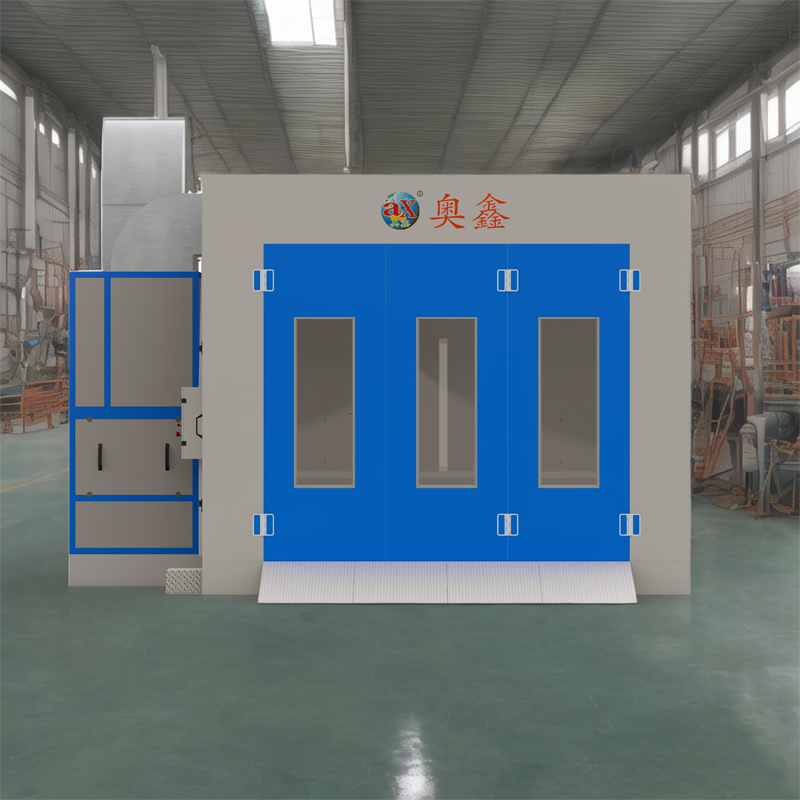আধুনিক পেইন্ট স্প্রে বুথের প্রয়োজনীয় উপাদানগুলি বোঝা
পেইন্ট স্প্রে বুথ বিভিন্ন শিল্পে নিরাপদ, দক্ষ এবং উচ্চমানের পেইন্টিং অপারেশন নিশ্চিত করার জন্য জটিল প্রকৌশল ব্যবস্থা প্রতিনিধিত্ব করে। অটোমোটিভ রিফিনিশিং থেকে শুরু করে শিল্প উত্পাদন পর্যন্ত, এই নিয়ন্ত্রিত পরিবেশগুলি পেশাদার পেইন্টিং প্রক্রিয়ার প্রতিষ্ঠার জন্য অপরিহার্য। পেইন্ট স্প্রে বুথের জটিলতা এবং কার্যকারিতা সম্পর্কে পুরোপুরি ধারণা পেতে হলে এর মৌলিক উপাদানগুলি বিশ্লেষণ করা প্রয়োজন যা সঠিক পেইন্টিং পরিবেশ তৈরিতে সমন্বিতভাবে কাজ করে।
ভেন্টিলেশন এবং এয়ারফ্লো সিস্টেম
বায়ু পূরণ ইউনিট এবং সরবরাহ
পেইন্ট স্প্রে বুথের মধ্যে ভেন্টিলেশন সিস্টেম হল কেন্দ্রীয় অংশ, যা সঠিক বায়ু প্রবাহ বজায় রাখার এবং পরিষ্কার পেইন্টিং পরিবেশ নিশ্চিত করার জন্য দায়ী। ভালোভাবে ডিজাইন করা একটি বায়ু পূরণ ইউনিট (AMU) বুথের মধ্যে তাজা, ফিল্টারযুক্ত বায়ু প্রবেশ করায় যখন সর্বোত্তম তাপমাত্রা এবং আর্দ্রতা বজায় রাখে। এই অংশটি ক্রমাগত ভাবে বায়ু প্রতিস্থাপন করে যা বাইরে নির্গত হয়, নিখুঁত পেইন্ট প্রয়োগের জন্য প্রয়োজনীয় সঠিক এবং নিয়ন্ত্রিত পরিবেশ তৈরি করে।
আধুনিক পেইন্ট স্প্রে বুথ সিস্টেমগুলি উন্নত বায়ু সরবরাহ পদ্ধতি ব্যবহার করে যা প্রতি মিনিটে 60 থেকে 100 ফুট পর্যন্ত স্থিতিশীল বায়ুপ্রবাহ সরবরাহ করতে সক্ষম, যা অ্যাপ্লিকেশনের প্রয়োজনীয়তা অনুযায়ী পরিবর্তিত হয়। বুথে প্রবেশের আগে আগত বায়ু একটি পূর্ব-ফিল্টার সিরিজের মধ্য দিয়ে যায়, যা সম্ভাব্য দূষণকারী অপসারণ করে যা ফিনিশের মানকে প্রভাবিত করতে পারে।
নির্গমন এবং ফিল্টারেশন সিস্টেম
একটি পেইন্ট স্প্রে বুথে নিঃসরণ ব্যবস্থার পেইন্টের অতিরিক্ত স্প্রে, ধোঁয়া এবং উদ্বায়ী জৈব যৌগ (VOCs) পেইন্টিং পরিবেশ থেকে অপসারণের গুরুত্বপূর্ণ কাজ রয়েছে। প্রাথমিক ফিল্টার, দ্বিতীয়ক ফিল্টার এবং কখনও কখনও HEPA ফিল্টার সহ একাধিক পর্যায়ের ফিল্টারেশন বিভিন্ন আকারের পেইন্ট কণা ধারণ করার জন্য একত্রে কাজ করে, তারপর বাতাস বাইরে নিষ্কাশিত হয়।
অ্যাডভান্সড পেইন্ট স্প্রে বুথ ডিজাইনগুলি নতুন ফিল্টার বিন্যাস অন্তর্ভুক্ত করে যা বায়ুপ্রবাহ প্রতিরোধ কমিয়ে কণা ধারণ দক্ষতা সর্বাধিক করে। এই ব্যবস্থাগুলি সাধারণত 98-99% ফিল্টারেশন দক্ষতা অর্জন করে, পরিবেশগত মানদণ্ড এবং অপারেটর নিরাপত্তা দুটোই নিশ্চিত করে।

আলোকসজ্জা এবং দৃশ্যমানতা উপাদান
আলোকিত সিস্টেম
সঠিক আলোকসজ্জা রঙের সঠিক মিল আনা এবং সমানভাবে রং প্রয়োগ নিশ্চিত করার জন্য পেইন্ট স্প্রে বুথের ক্ষেত্রে অত্যন্ত গুরুত্বপূর্ণ। শিল্প-মানের পেইন্ট স্প্রে বুথগুলিতে কৌশলগতভাবে স্থাপিত আলোকসজ্জা থাকে যা কাজের সম্পূর্ণ এলাকাজুড়ে সমান, ছায়ামুক্ত আলোকসজ্জা প্রদান করে। এই আলোকসজ্জাগুলি সাধারণত বিশেষ ধরনের বাল্ব ব্যবহার করে যা প্রাকৃতিক দিনের আলোর অনুরূপ হয়, যার রঙ প্রতিফলন সূচক (CRI) 90 বা তার বেশি।
অধিকাংশ আধুনিক বুথগুলিতে LED আলোকসজ্জা ব্যবস্থা অন্তর্ভুক্ত থাকে যা উচ্চতর শক্তি দক্ষতা, দীর্ঘ আয়ু এবং স্থিতিশীল রঙের তাপমাত্রা প্রদান করে। এই আলোকসজ্জাগুলি সাধারণত সীলযুক্ত এবং বিস্ফোরক-প্রতিরোধী হয়, যা ঝুঁকিপূর্ণ পরিবেশের জন্য কঠোর নিরাপত্তা প্রয়োজনীয়তা পূরণ করে।
পর্যবেক্ষণ জানালা এবং প্রবেশ পথ
পেইন্ট স্প্রে বুথ পরিচালনার ক্ষেত্রে দৃশ্যমান নিরীক্ষণ ক্ষমতা অত্যন্ত গুরুত্বপূর্ণ। পর্যবেক্ষণ জানালা সাধারণত টেম্পারড বা সেফটি গ্লাস দিয়ে তৈরি করা হয়, যা তত্ত্বাবধায়কদের বুথে প্রবেশ না করেই পেইন্টিং প্রক্রিয়া নিরীক্ষণ করতে দেয়। এই জানালাগুলি রাখা হয় যথাযথ স্থানে যাতে দর্শনের সেরা কোণ পাওয়া যায় এবং বুথের ধারণক্ষমতা অক্ষুণ্ণ রাখা যায়।
সঠিক বুথ চাপাধরণ বজায় রেখে সহজে প্রবেশ ও প্রস্থানের জন্য প্রবেশ পথ এবং দরজা নিখুঁতভাবে নির্মিত হয়। অনেক আধুনিক পেইন্ট স্প্রে বুথে দ্রুত গতিসম্পন্ন দরজা বা বায়ু-সিল করা প্রবেশদ্বার রয়েছে যা পরিচালনার সময় দূষণের ঝুঁকি কমিয়ে দেয়।
নিয়ন্ত্রণ এবং নিরীক্ষণ পদ্ধতি
পরিবেশগত নিয়ন্ত্রণ
একটি পেইন্ট স্প্রে বুথের জটিল নিয়ন্ত্রণ ব্যবস্থা তাপমাত্রা, আর্দ্রতা এবং বায়ুচাপের মতো পরামিতি নিয়ন্ত্রণ করে। ডিজিটাল নিয়ন্ত্রণ প্যানেলগুলি বাস্তব সময়ে পর্যবেক্ষণ এবং সমন্বয়ের সুবিধা প্রদান করে, যা পেইন্ট প্রয়োগের জন্য আদর্শ অবস্থা নিশ্চিত করে। এই ব্যবস্থাগুলি সাধারণত পেইন্টের আসঞ্চন ও পাকানোর জন্য আদর্শ অবস্থা বজায় রাখতে 65-75°F তাপমাত্রা এবং 50-65% আপেক্ষিক আর্দ্রতা স্তর বজায় রাখে।
উন্নত পেইন্ট স্প্রে বুথগুলিতে স্বয়ংক্রিয় জলবায়ু নিয়ন্ত্রণ ব্যবস্থা অন্তর্ভুক্ত থাকে যা বাহ্যিক অবস্থা, পণ্যের প্রয়োজনীয়তা এবং পরিচালন পর্যায়ের ভিত্তিতে সেটিংস সামঞ্জস্য করতে পারে। এই স্মার্ট নিয়ন্ত্রণগুলি ধ্রুব্যতা বজায় রাখতে সাহায্য করে এবং শক্তি দক্ষতা অনুকূলিত করে।
নিরাপত্তা পর্যবেক্ষণ সরঞ্জাম
পেইন্ট স্প্রে বুথ পরিচালনার ক্ষেত্রে নিরাপত্তা পর্যবেক্ষণ উপাদানগুলি একটি গুরুত্বপূর্ণ দিক গঠন করে। এতে VOC সেন্সর, চাপ পার্থক্য মনিটর এবং জরুরি বন্ধ করার ব্যবস্থা অন্তর্ভুক্ত থাকে। আধুনিক বুথগুলিতে একীভূত নিরাপত্তা প্রোটোকল থাকে যা স্বয়ংক্রিয়ভাবে পরিচালনা সামঞ্জস্য করে যখন পরামিতিগুলি গ্রহণযোগ্য পরিসরের বাইরে চলে যায়।
অগ্নিনিরোধক ব্যবস্থা, জরুরি আলোকসজ্জা এবং ভেন্টিলেশন ব্যাকআপ সিস্টেম অতিরিক্ত সুরক্ষা সুবিধা প্রদান করে। এই উপাদানগুলি একত্রে কাজ করে এমন একটি নিরাপদ কর্মক্ষেত্র তৈরি করে যা শিল্পের নিরাপত্তা মানদণ্ডকে পূরণ করে বা ছাড়িয়ে যায়।
প্রায়শই জিজ্ঞাসিত প্রশ্নাবলী
পেইন্ট স্প্রে বুথ ফিল্টারগুলি কত ঘন ঘন প্রতিস্থাপন করা উচিত?
ফিল্টার প্রতিস্থাপনের ঘনত্ব ব্যবহারের তীব্রতা এবং আবরণ উপকরণের ধরনের উপর নির্ভর করে। সাধারণত, ইনটেক ফিল্টারগুলি মাসিক পরীক্ষা করা উচিত এবং প্রতি 3-6 মাস অন্তর প্রতিস্থাপন করা উচিত। নিষ্কাশন ফিল্টারগুলির সাধারণত আরও ঘন ঘন পরিবর্তনের প্রয়োজন হয়, স্বাভাবিক অপারেশন অবস্থায় প্রায়শই প্রতি 1-3 মাস অন্তর। নিয়মিত চাপ পতন নিরীক্ষণ অনুকূল প্রতিস্থাপনের সময় নির্ধারণে সাহায্য করে।
একটি স্ট্যান্ডার্ড পেইন্ট স্প্রে বুথের জন্য বিদ্যুৎ প্রয়োজনীয়তা কী কী?
বুথের আকার এবং বৈশিষ্ট্যের উপর ভিত্তি করে বিদ্যুৎ প্রয়োজনীয়তা পরিবর্তিত হয়। সাধারণত, শিল্প পেইন্ট স্প্রে বুথগুলি মূল অপারেশনের জন্য 230/460V তিন-ফেজ বিদ্যুৎ প্রয়োজন করে। আলোকসজ্জা সার্কিটগুলি সাধারণত 120V একক-ফেজ বিদ্যুতে চলে। বুথের বিন্যাস এবং ভেন্টিলেশনের প্রয়োজনীয়তার উপর ভিত্তি করে মোট বিদ্যুৎ খরচ 10 থেকে 50 kW এর মধ্যে হতে পারে।
কি পেইন্ট স্প্রে বুথগুলি নির্দিষ্ট অ্যাপ্লিকেশনের জন্য কাস্টমাইজড করা যেতে পারে?
হ্যাঁ, পেইন্ট স্প্রে বুথগুলি নির্দিষ্ট পরিচালন প্রয়োজনীয়তা মেটানোর জন্য অত্যন্ত কাস্টমাইজড করা যেতে পারে। এতে বিশেষ ফিল্টারেশন সিস্টেম, কাস্টম মাত্রা, অতিরিক্ত আলোকসজ্জা, উন্নত নিয়ন্ত্রণ ব্যবস্থা এবং নির্দিষ্ট বায়ুপ্রবাহ প্যাটার্ন অন্তর্ভুক্ত থাকতে পারে। অভিজ্ঞ প্রস্তুতকারকদের সাথে কাজ করে নিরাপত্তা এবং পরিবেশগত নিয়মাবলীর সাথে সম্মতি রেখে সঠিকভাবে কাস্টমাইজেশন করা হয়।

